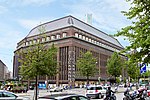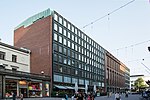DTM (nightclub)

DTM (originally Don't Tell Mama) is an LGBT nightclub in Helsinki, Finland. Founded in 1992, it is the largest gay club in Northern Europe. The venue was initially situated in Helsinki's Kamppi neighborhood, having since relocated twice: first, to Iso Roobertinkatu in Punavuori in 2003, and second, to Mannerheimintie in Kluuvi in 2012. Popular with gay men, DTM also caters to a straight and lesbian customer base. The club's playlists contain primarily pop songs, dance music, techno and Finnish hits, with live entertainment often taking the form of drag shows. Through an agreement with UK-based promoter Klub Kids, DTM began to host visiting performers from RuPaul's Drag Race in January 2019. The establishment has been in a state of temporary closure since June 2020, when it halted operation following a protracted conflict over noise complaints from a neighboring hotel. Its management has stated that it will reopen once a suitable new space is secured.
Excerpt from the Wikipedia article DTM (nightclub) (License: CC BY-SA 3.0, Authors, Images).DTM (nightclub)
Mannerheimintie, Helsinki Kaartinkaupunki (Southern major district)
Geographical coordinates (GPS) Address Nearby Places Show on map
Geographical coordinates (GPS)
| Latitude | Longitude |
|---|---|
| N 60.1671 ° | E 24.9417 ° |
Address
Mannerheimintie 6
00101 Helsinki, Kaartinkaupunki (Southern major district)
Finland
Open on Google Maps











